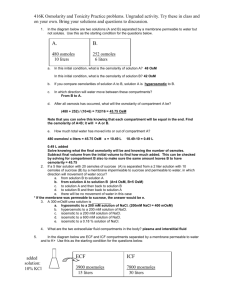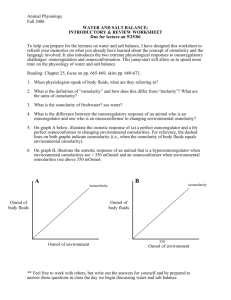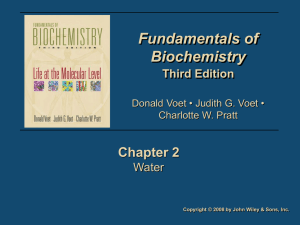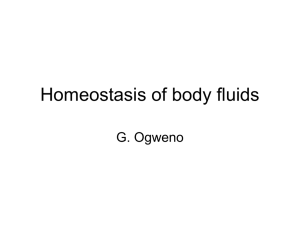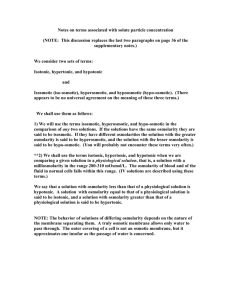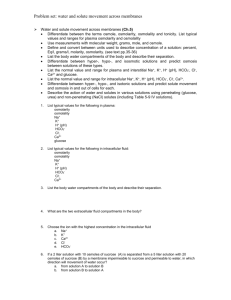examples from renal physiology good teaching and good testing
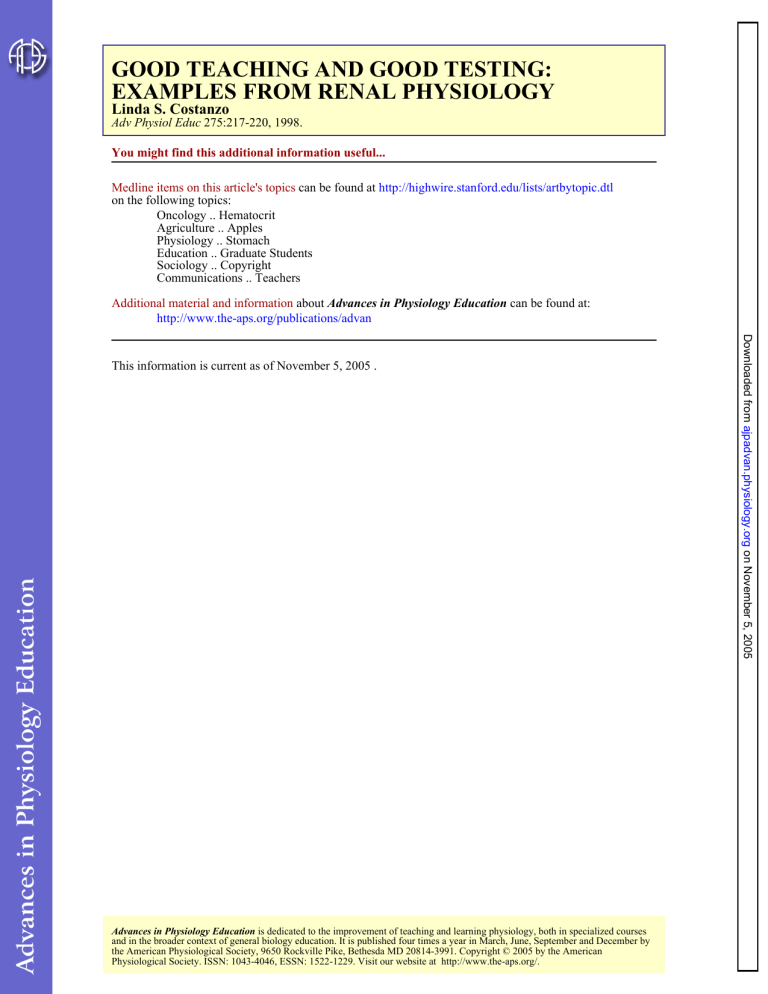
GOOD TEACHING AND GOOD TESTING:
EXAMPLES FROM RENAL PHYSIOLOGY
Linda S. Costanzo
Adv Physiol Educ 275:217-220, 1998.
You might find this additional information useful...
Medline items on this article's topics can be found at http://highwire.stanford.edu/lists/artbytopic.dtl
on the following topics:
Oncology .. Hematocrit
Agriculture .. Apples
Physiology .. Stomach
Education .. Graduate Students
Sociology .. Copyright
Communications .. Teachers
Additional material and information about Advances in Physiology Education can be found at: http://www.the-aps.org/publications/advan
This information is current as of November 5, 2005 .
Advances in Physiology Education is dedicated to the improvement of teaching and learning physiology, both in specialized courses and in the broader context of general biology education. It is published four times a year in March, June, September and December by the American Physiological Society, 9650 Rockville Pike, Bethesda MD 20814-3991. Copyright © 2005 by the American
Physiological Society. ISSN: 1043-4046, ESSN: 1522-1229. Visit our website at http://www.the-aps.org/.
A P S R E F R E S H E R C O U R S E R E P O R T
GOOD TEACHING AND GOOD TESTING:
EXAMPLES FROM RENAL PHYSIOLOGY
Linda S. Costanzo
Virginia Commonwealth University, Medical College of Virginia,
Richmond, Virginia 23298
Making the connections between good teaching and good testing can be tricky. How, as faculty, do we complete the cycle of good teaching by testing our students fairly? How do we challenge the students to demonstrate what they have learned and, at the same time, evaluate them for purposes of grading? How do we ensure that they have learned what is important?
The teaching and testing of renal physiology is ideal for a discussion of these issues because of its inherent demand for problem-solving and quantitation.
First, let me make several clarifications.
1 ) My purpose here is to discuss philosophy and attitudes, not to provide a how-to on question writing.
2 ) I will not argue the advantages of different question types (multiple choice, essay, short answer) because any type can be rigorous and creative, or trivial.
3 ) This discussion focuses on the teaching and testing of medical and graduate students, because that is my primary experience.
4 ) By ‘‘teaching’’ I refer to any venue in which teacher meets student, not just the lecture hall. I refer also to laboratories, problemsolving sessions, chance meetings in stairwells for brief questions, scheduled meetings in the office for more in-depth discussion, and even the interactions that occur during testing.
THE CHALLENGE
One issue we face in testing is that if we teach ‘‘too well,’’ the students will perform ‘‘too well’’ on our examinations. We risk being criticized for being too easy, for not devising a good evaluative tool, and possibly even for apple-polishing to win students’ favor. This inherent conflict (writing exams that complete the cycle of good teaching and that satisfy the evaluative task) may drive faculty to focus too much on the examination and not enough on the teaching.
We may attempt to resolve the problem by devising tests with enough minutiae to separate the top of the class from the bottom. In another scenario, we may
‘‘hold back’’ something in our teaching and ‘‘save’’ it for the exam, something that was not taught explicitly or implicitly. For a healthy approach, as I will suggest later in the article, we can both teach well and test well by purposefully developing the subtle connections.
UNHEALTHY SOLUTIONS
The first solution (resorting to minutiae) requires little comment. It is cheap and easy for the teacher, it separates the class, and it rewards students who have the mind and stomach for learning trivia. It has no long-term benefit for the student or for the teacher
(who, potentially, has a lot to learn from his examinations). Furthermore, testing offices are notorious for not understanding that these highly discriminating questions often test minor points of no lasting value.
All that glitters is not gold!
The second course (holding out something for the examination) seemingly is more defensible, but also is more insidious. It is more defensible because the teacher can rightly argue that students should be required to extend and apply their knowledge. Of course they should! This is how it works. Let us say we are teaching the physiology of fluid shifts that occur in response to disturbances of osmolarity. We select, as an example, the responses to salt ingestion. We take the students through a methodical approach and through the conceptual steps: ingestion of salt raises the solute content and osmolarity of the extracel-
1043 - 4046 / 98 – $5.00 – COPYRIGHT r 1998 THE AMERICAN PHYSIOLOGICAL SOCIETY
VOLUME 20 : NUMBER 1 – ADVANCES IN PHYSIOLOGY EDUCATION – DECEMBER 1998
S217
A P S R E F R E S H E R C O U R S E R E P O R T lular fluid (ECF), which leads to a shift of water from intracellular fluid (ICF) to ECF so that, in the new steady state, ICF volume is decreased and ECF volume is increased. We further explain that hematocrit decreases because of the dilutional effect of the increased ECF volume. However, if we are ‘‘holding back,’’ we intentionally fail to mention, or mention casually as if it were hardly important, that a second reason hematocrit decreases is that red blood cells shrink as water leaves the ICF, i.e., red blood cells are cells .
We ‘‘held back’’ because we planned to ask a question on the examination about salt ingestion and red cell shrinkage as a cause of decreased hematocrit. To make it especially difficult, we may ask our question in the multiple-multiple choice (K type) format, in which students get no credit for knowing how volumes and osmolarity and hematocrit change; students get the question right only if they know that a water shift out of red blood cells contributes to the decrease in hematocrit. The question will be difficult; it will separate men from boys (as they say), and it will win us favor in the testing office, where our performance is evaluated by the ‘‘spread’’ of the class on our questions.
On the surface, there is nothing wrong here. All students learned the basics about changes in osmolarity and volume (even if they did not have the satisfaction of demonstrating that knowledge). The question was highly discriminating. The question tested an important, not trivial, point. The students were required to extend and apply their knowledge, a desirable feature.
But, there is something terribly wrong here. What is wrong, and I believe professionally unacceptable, is the decision not to teach an important concept for the sake of making a ‘‘good’’ test question. We decided to have the students ‘‘learn’’ this concept on the examination. ‘‘Learn’’ is a manner of speaking, because this is a most haphazard form of teaching and learning unless we follow up with a thorough postexam review. More often than not, there is no such followup, and the students chalk it up to one more question missed and move on to the next section of the course.
We missed an opportunity to teach by never giving a single clue before the examination that shrinking and swelling of red blood cells is important.
A HEALTHY PHILOSOPHY
The issue boils down to teaching as well as we can and then testing as well as we can. Our job is to teach with integrity, which means to give the students everything we have. By ‘‘everything we have,’’ I do not mean delivering the material on a silver platter in lecture. I mean bombarding the students with as many examples as we can, reinforcing principles as often as we can, and endeavoring to reach every single student, weak and strong. We stay on task because we regard our job as vitally important to professional students and to the health of their future patients or students. As we teach, we should forget about the examination and be single-minded in our purpose.
Just as it is unconscionable to ‘‘teach to the test,’’ it is equally or more unconscionable to ‘‘teach away from the test.’’
Creating the examination is then a separate task that is linked to our teaching in the following way: just as we teach what is important, so we test what is important.
A simple guiding premise is that if a point is important enough to test on the examination, then certainly it is important enough to teach. It is that simple.
AN EXAMPLE
Now, to illustrate a healthy approach to linking teaching and testing, let us return to our example of fluid shifts. The first and most important step is to decide what will be included in this area of instruction. We must decide which principles will be taught, illustrated, and embellished with examples. Which principles will the student need in order to understand the pathophysiology of fluid and electrolyte balance? Which principles will the student need for the rest of his or her career? These will include how to predict changes in osmolarity and fluid shifts, what factors contribute to changes in hematocrit and plasma protein concentration, and how to calculate osmolarities and volumes after a disturbance of fluid and osmotic balance. By carefully selecting our examples, we then guide the students from the simple to the complex, adding difficulty and nuances that keep it interesting and fresh. If we are fortunate enough to teach in small groups, students can take the lead and
VOLUME 20 : NUMBER 1 – ADVANCES IN PHYSIOLOGY EDUCATION – DECEMBER 1998
S218
A P S R E F R E S H E R C O U R S E R E P O R T instruct each other. If not, we can teach interactively in lecture. If we find ourselves blessed with five extra minutes at the end of a lecture or problem-session, we have a ready example with a different twist. The students understand how important the material is, in large part, because of the emphasis we give. We can forget about the questions we wrote for the examination because, in that separate process, we paid due diligence to the very same issues: what principles must the student know for life?
THE QUESTIONS
So... what about the examination questions? Given the significance of this area, the relative number of questions will be high. Let us say we are preparing an examination with four questions on fluid shifts. All questions should include a degree of problem solving, stepwise thinking, and integration, which can vary in difficulty. The examination questions should be a good all-around package that shows the students they have mastered an important area, that they are prepared for the next level of pathophysiology, and that they know what they need to know. It should be fun and challenging and satisfying, and, because the questions require a high level of mastery and problemsolving skills, they will be sufficiently discriminating.
Now, for some actual questions. The examples I have chosen are in the short-answer and multiple-choice A type formats.
Question 1
A woman runs the New York City Marathon on a 90° day. It is determined that she loses 3 liters of sweat, which is hypotonic. During the marathon, she drinks
3 liters of H
2
O. For each parameter listed below, indicate whether it is increased, decreased, or unchanged in the new steady state, and why.
Increased, Decreased, or Unchanged Why
Plasma osmolarity
ECF volume
Hematocrit
Total body water
Comments on question 1.
This is a substantial question! The student first must unequivocally determine what was gained or lost (i.e., net loss of NaCl with no net loss of H
2
O). The student must then determine what this loss of NaCl will do to ECF and plasma osmolarity (decrease it). The student must then determine whether this decrease in ECF osmolarity will lead to a fluid shift across cell membranes (yes) and in what direction the shift will occur (from ECF to
ICF, leading to a decrease in ECF volume). As an alternative, we could have asked what happens to ICF volume (it will increase). To ascertain the change in total body water, the student must return to the initial disturbance and confirm that there is no net gain or loss of H
2
O and thus conclude that there is no change in total body water. Finally, the student must determine what happens to hematocrit (it will increase) and say why (the decrease in ECF volume concentrates the red blood cells and the shift of water into cells causes the red blood cells to swell). There is nothing trivial about this question, nothing that could have been memorized to arrive at the correct answers.
There is nothing tricky or underhanded—each step in the correct approach had been demonstrated in other examples before the test.
Question 2
Subjects A and B are 70-kg male subjects with the same total body water.
Subject A eats dry NaCl.
Subject B drinks a solution of isosmotic (and isotonic)
NaCl. After the new steady state is reached (but before any of the ingested substances are excreted), which of the following is true?
a ) Subject A will have a higher ICF volume than subject B .
b ) Subject A will have a higher circulating level of antidiuretic hormone (ADH) than subject B .
c ) Subject B will have a higher plasma Na
1 concentration than subject A .
d ) Subject B will have a higher ICF osmolarity than subject A .
e ) Both subjects will have an increased hematocrit.
Comments on question 2.
The answer is b . The student must determine what happens in subject A
(hyperosmotic volume expansion) and subject B (isosmotic volume expansion) and the consequences of those changes on ADH levels, Na
1 concentration, and hematocrit. The difficulty of the question is increased because a comparison of the two subjects must be made at each step. The introduction of ADH is fair because it forces the student to integrate other ele-
VOLUME 20 : NUMBER 1 – ADVANCES IN PHYSIOLOGY EDUCATION – DECEMBER 1998
S219
A P S R E F R E S H E R C O U R S E R E P O R T ments of osmoregulation. The introduction of plasma
Na
1 concentration also is fair because the student has learned the usual relationship between Na
1 and osmoles. There are no short-cuts to the answer and no clues in the distractors. The student works hard for the answer and is rewarded if he or she is willing to do the work.
Question 3
A man with an intracellular volume of 25 liters, an extracellular volume of 15 liters, and a plasma osmolarity of 300 mosmol/l eats a bag of potato chips containing a total of 800 mosmol of NaCl. Simultaneously, he drinks 1 liter of H
2
O. Assume that none of the NaCl or H
2
O is excreted. What is the man’s plasma osmolarity after a new steady state is reached?
a ) 302 mosmol/l b ) 309 mosmol/l c ) 312 mosmol/l d ) 331 mosmol/l e ) 353 mosmol/l
Comments on question 3.
The answer is c . Answering the question qualitatively (i.e., determining that
ECF osmolarity will increase) does not eliminate any options. The student must do a correct series of calculations by first computing total body water and total body osmoles, adding the number of osmoles ingested, and, finally, computing the new osmolarity by dividing the new total body osmoles by the new total body water. As written, most students will get this question right because they will have done many similar calculations. However, the difficulty of the question can be increased by giving the grams of NaCl ingested and the molecular weight and osmotic coefficient of NaCl so that the student must convert grams to osmoles.
Question 4
A man with an intracellular volume of 25 liters, an extracellular volume of 15 liters, and a plasma osmolarity of 300 mosmol/l eats a bag of corn chips containing a total of 900 mosmol of NaCl. Simultaneously, he drinks 3 liters of H
2
O. Assume that none of the NaCl or
H
2
O is excreted. After the new steady state is reached, his intracellular fluid volume will be (compared to before the ingestion): a ) increased by 1.0 liter b ) increased by 1.2 liter c ) decreased by 1.8 liter d ) decreased by 1.0 liter e ) unchanged
Comments on question 4.
The answer is e . Most students will do a multistep calculation to arrive at the correct answer, involving first calculating osmolarity in the new steady state, calculating how many osmoles are in the ICF (knowing that the ingested NaCl is added only to the ECF), and then calculating the new ICF volume by dividing ICF osmoles by the new osmolarity. If they do the calculation correctly, they will find that the new ICF volume is the same as the original ICF volume! Some students, not expecting
‘‘unchanged’’ to be the answer, will double-check their calculations. Others will now notice that the ingestate was isosmotic (900 mosmol and 3 liters of
H
2
O) and, therefore, should produce no fluid shift and no change in ICF volume. The most astute and confident students will have determined this in their initial assessment of the question and will have streamlined their work considerably!
SUMMARY
Hopefully, this simple example of fluid shifts demonstrates that there can be a healthy relationship between teaching, testing, and learning. Teaching and learning are our agenda! Testing has no separate importance, other than for evaluation and grading; this can be accomplished with questions that demand critical thinking, problem-solving, and integration.
With some extra effort, we can create a wholesome process whereby both teacher and student feel good about their hard work.
Address reprint requests to the author at Virginia Commonwealth
University, Medical College of Virginia, Richmond, VA 23298.
VOLUME 20 : NUMBER 1 – ADVANCES IN PHYSIOLOGY EDUCATION – DECEMBER 1998
S220
